Enter the name for this tabbed section: About the Paso Fino
The Paso Fino (pronounced pah-so fee-no) horse is the smoothest riding horse in the world. Once you've ridden a Paso Fino you won't be satisfied riding any other horse! Paso Finos range in size from 13.1 hands to 15.2 hands, with the average height being 14.1 hands. Don't underestimate the horse because of their size. This horse can easily carry a large rider comfortably for an extended period of time. An average Paso can easily carry a rider who is over 6 feet tall and weighing 250 lbs over the worst trails - up and down hills and through water without any difficulty. And, the rider is not tired or sore! Paso Finos are able to accomplish this because of their conformation and even, four-beat lateral gait. Take a few minutes to learn more about this wonderful horse...it's an incredible riding experience!
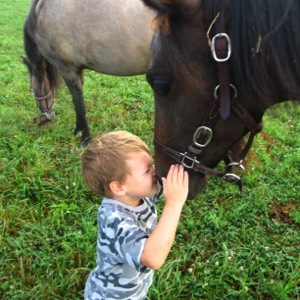
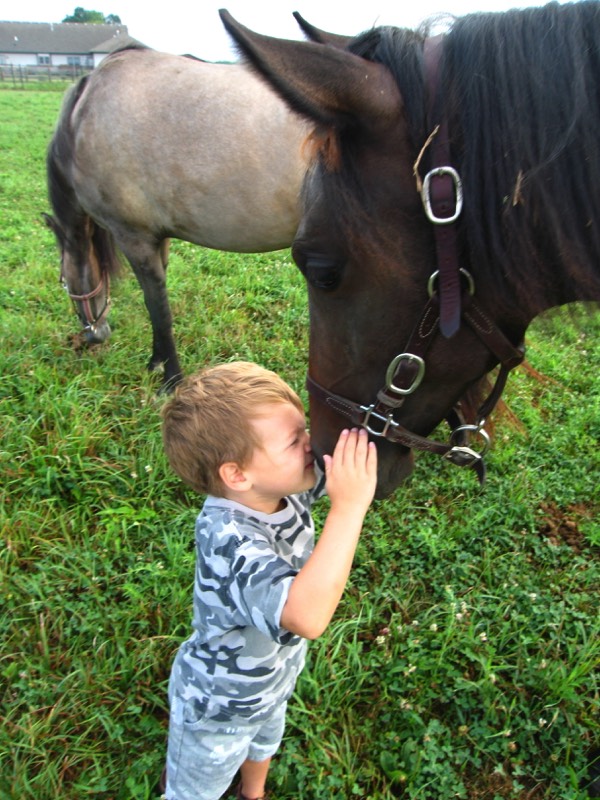
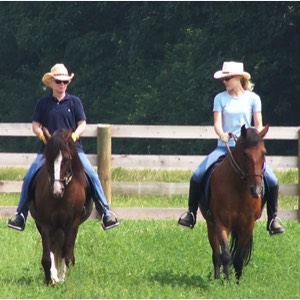
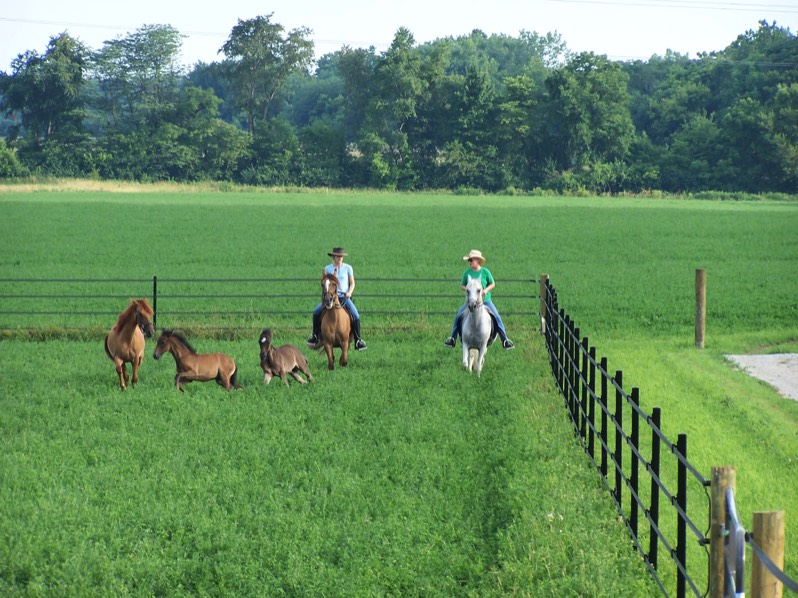
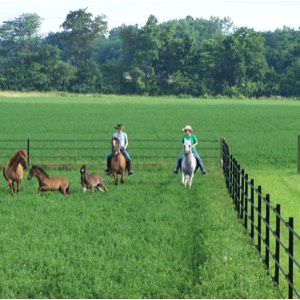

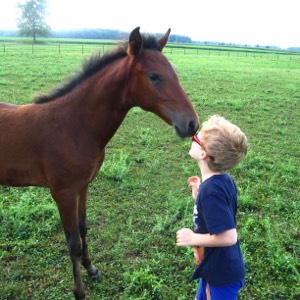
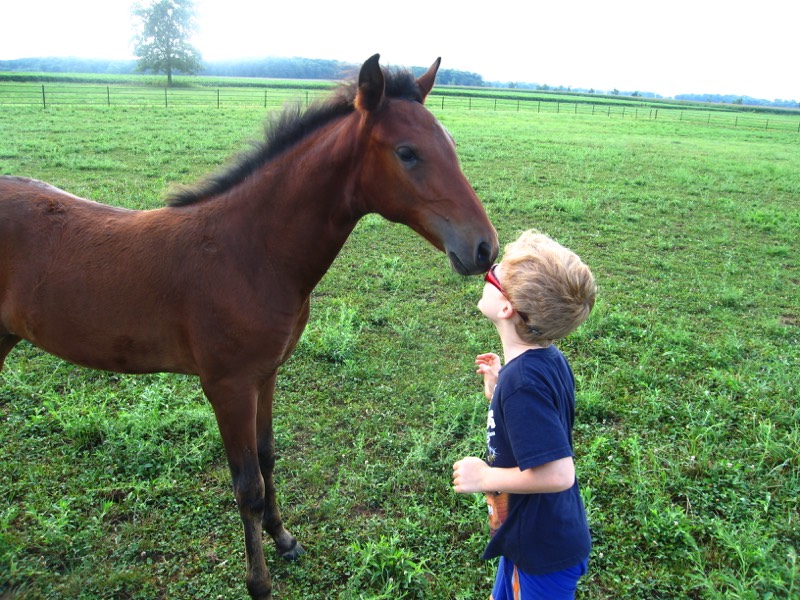
Enter the name for this tabbed section: History of the Paso Fino
When Christopher Columbus made his second voyage to the New World, he brought with him a select group of twenty-five horses. These horses had to be relatively small, but powerful enough to carry the heavily armored Conquistadors. The horses he selected came from the Spanish provinces of Andalusia and Cordela. This breed was a mixture of the Andalusian, the Spanish Barb from North Africa, and the Spanish Jennet (now extinct as a breed). The Spanish Jennet not only possessed an extremely comfortable saddle gait, but also able to pass the gait on to its offspring. The result of the blending of these horses was a relatively small, but powerful horse with an incredibly smooth gait. The Conquistadors called them “los caballos de paso fino”, which translates as “the horses with the fine walk”. Over time the Paso Fino was interbred with other European horses and disappeared from North America as a distinct breed.
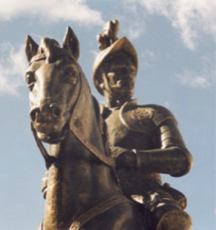
Their influence can be seen, though, in the lineage of the Spanish Mustang, not to be confused with the feral mustangs managed by the Bureau of Land Management.
Latin breeders in South America and the Caribbean Islands, however, prized these wonderful Paso Fino horses and developed this breed into what we call today the modern Paso Fino horse. Over the years, selective breeding produced regional variations of the Paso Fino in Puerto Rico, Peru, Cuba and Columbia.
The reintroduction of the Paso Fino in the North American continent began in the 1940s when American service personnel stationed in Puerto Rico discovered the Paso Fino and brought them back with them to the mainland. In the 1960s Americans began to import the Columbian Paso Fino to further enhance the quickness of the Paso Fino gait. Today there are over 35,000 registered Paso Finos in the United States representing about 14,000 owners.
Latin breeders in South America and the Caribbean Islands, however, prized these wonderful Paso Fino horses and developed this breed into what we call today the modern Paso Fino horse. Over the years, selective breeding produced regional variations of the Paso Fino in Puerto Rico, Peru, Cuba and Columbia.
The reintroduction of the Paso Fino in the North American continent began in the 1940s when American service personnel stationed in Puerto Rico discovered the Paso Fino and brought them back with them to the mainland. In the 1960s Americans began to import the Columbian Paso Fino to further enhance the quickness of the Paso Fino gait. Today there are over 35,000 registered Paso Finos in the United States representing about 14,000 owners.
Enter the name for this tabbed section: Conformation of the Paso Fino
The Paso Fino is born with a gait unique to the breed, and his attitude seems to transmit to the observer that this horse knows his gait is a very special gift that must be executed with style and pride! The gait, being totally natural, does not exhibit the catapulting or exaggerated leg action of man made gaits: rather the movements are smooth, rhythmic, purposeful, straight, balanced in flexion and synchronous front to rear, resulting in unequalled comfort and smoothness for the rider.
Head: The head should be refined and in good proportion to the body of the horse, neither extremely small nor large with the preferred profile being straight. Eyes are large and well spaced, very expressive and alert, and should not show excessive white around the edges. Ears are comparatively short, set close, and curved inward at the tips. The lips should be firm and the nostrils large and dilatable. Jaws are defined but not extreme. The impression should be of a well-shaped, alert, and intelligent face.
Head: The head should be refined and in good proportion to the body of the horse, neither extremely small nor large with the preferred profile being straight. Eyes are large and well spaced, very expressive and alert, and should not show excessive white around the edges. Ears are comparatively short, set close, and curved inward at the tips. The lips should be firm and the nostrils large and dilatable. Jaws are defined but not extreme. The impression should be of a well-shaped, alert, and intelligent face.
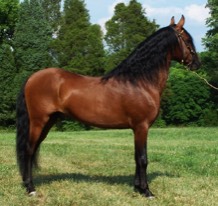
Neck: Gracefully arched, medium in length and set on at an angle to allow high carriage, breaking at the poll. Throat latch should be refined and well-defined.
Forehand: Shoulders are sloping into the withers with great depth through the heart. Chest is moderate in width. Withers are defined but not pronounced and slope smoothly into the back.
Legs: Straight with refined bones and strong, well defined tendons. Broad, long fore-arms with shorter cannons. Thigh and gaskins are strong and muscled, but not exaggerated. Standing slightly under in the rear is typical. Pasterns are sloping and medium in length. Bones are straight, sound and flat, and joints are strong and well defined. Hooves are well rounded, proportionate in size, and do not show excessive heel.
Forehand: Shoulders are sloping into the withers with great depth through the heart. Chest is moderate in width. Withers are defined but not pronounced and slope smoothly into the back.
Legs: Straight with refined bones and strong, well defined tendons. Broad, long fore-arms with shorter cannons. Thigh and gaskins are strong and muscled, but not exaggerated. Standing slightly under in the rear is typical. Pasterns are sloping and medium in length. Bones are straight, sound and flat, and joints are strong and well defined. Hooves are well rounded, proportionate in size, and do not show excessive heel.
Mane, tail and forelock: As long, full and luxurious as nature can provide. No artificial additions or alterations are allowed. A bridle path not exceeding 4" is acceptable.
Size: 13 to 15.2 hands with 13.3 to 14.2 being the most typical. Weight from 700 to 1100 lbs. Full size may not be attained until the fifth year.
Color: Every equine color can be found, with or without white markings.
Disposition: An extremely willing horse that truly seems to enjoy human companionship and strives to please. Spirited and responsive under tack; sensible and gentle at hand.
Size: 13 to 15.2 hands with 13.3 to 14.2 being the most typical. Weight from 700 to 1100 lbs. Full size may not be attained until the fifth year.
Color: Every equine color can be found, with or without white markings.
Disposition: An extremely willing horse that truly seems to enjoy human companionship and strives to please. Spirited and responsive under tack; sensible and gentle at hand.
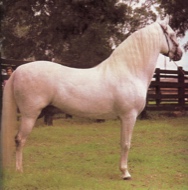
Midsection: Moderate in length with a well-sprung rib cage. Topline should be proportionately shorter than the underline. The back should be strong and muscled. The midsection should join the forehand and the hindquarters so as to give the horse a pleasing, proportioned appearance.
Hindquarters: Croup is slightly sloping with rounded hips, broad loins, and strong hocks. Tail is carried gracefully when horse is in motion.
The Paso Fino is a horse for all seasons, a horse for all climates, and a horse for diverse purposes. From the Florida Keys to the Pacific Northwest, and from southern California to New England, Eastern Canada, Puerto Rico, Colombia, and Europe, the Paso Fino demonstrated its remarkable versatility not just in the show ring, but on competitive trail and endurance rides, in dressage work, rodeo, gymkana, and back at the ranch working cattle. And he does it all with a gait that provides unparalleled comfort for the rider. The energy-efficient Paso Fino, with its unexcelled versatility, and unique comfort for the rider, opens a New World for horse lovers.
The Paso Fino is a naturally stylish horse. A good Paso Fino has a refined head, a long, proudly-carried neck, and overall good saddle conformation. Mane, tail and forelock are kept as long, full and luxurious as nature can provide. Although not as large as some breeds, he can carry a large rider comfortably for an extended period of time. His legs and feet are exceptionally tough and many Paso Fino's need no shoeing. There is no predominant color as all equine colors may be found. Paso Fino's are a flashy, all-around, intelligent mount with the bonus of continuous comfort for the rider. While the Paso Fino's great spirit is evident under saddle, his disposition allows even beginners to ride with ease.
Hindquarters: Croup is slightly sloping with rounded hips, broad loins, and strong hocks. Tail is carried gracefully when horse is in motion.
The Paso Fino is a horse for all seasons, a horse for all climates, and a horse for diverse purposes. From the Florida Keys to the Pacific Northwest, and from southern California to New England, Eastern Canada, Puerto Rico, Colombia, and Europe, the Paso Fino demonstrated its remarkable versatility not just in the show ring, but on competitive trail and endurance rides, in dressage work, rodeo, gymkana, and back at the ranch working cattle. And he does it all with a gait that provides unparalleled comfort for the rider. The energy-efficient Paso Fino, with its unexcelled versatility, and unique comfort for the rider, opens a New World for horse lovers.
The Paso Fino is a naturally stylish horse. A good Paso Fino has a refined head, a long, proudly-carried neck, and overall good saddle conformation. Mane, tail and forelock are kept as long, full and luxurious as nature can provide. Although not as large as some breeds, he can carry a large rider comfortably for an extended period of time. His legs and feet are exceptionally tough and many Paso Fino's need no shoeing. There is no predominant color as all equine colors may be found. Paso Fino's are a flashy, all-around, intelligent mount with the bonus of continuous comfort for the rider. While the Paso Fino's great spirit is evident under saddle, his disposition allows even beginners to ride with ease.
Enter the name for this tabbed section: The Paso Fino Gait
The Paso Fino can perform the same gaits as any other horse. It can do a flat walk, collected walk, canter, and gallup. But, a Paso Fino can do so much more! The Paso gait is essentially a broken pace gait which is lateral, not diagonal. The sequence of the footfall is hind hoof, same fore hoof, opposite hind hoof, same front hoof. The hind hoof touches the ground a fraction of a second before the front hoof. When performed on a hard surface, a definite 1,2,3,4 (ta-ca-ta-ca) can be heard. Propulsion is primarily from the hind legs yet the motion is absorbed through the back and loins. The croup remains relatively still. These aspects eliminate the jarring effects of a true pace, getting rid of the up and down movement. The Paso Fino can perform this natural gait at three speeds with varying levels of collection. It is not unusual to see newborn foals gaiting shortly after birth. This gait, though, gains more definition as the horse matures and can be refined through training. However, no special shoeing or artificial aids are necessary to make the Paso Fino gait.
The gait has three speeds: Classic Fino, Paso Corto, and Paso Largo. The horses perform the gait in three styles: the Classic Fino, Performance and the Pleasure styles. The Classic Fino gait is the most exciting to watch or to experience as a rider. The horse’s footfall is very rapid with an even rhythm. The forward movement is very slow, slower than a person would normally walk. The horse is completely collected, with an upright carriage and neck breaking at the poll at an almost vertical position.
The gait has three speeds: Classic Fino, Paso Corto, and Paso Largo. The horses perform the gait in three styles: the Classic Fino, Performance and the Pleasure styles. The Classic Fino gait is the most exciting to watch or to experience as a rider. The horse’s footfall is very rapid with an even rhythm. The forward movement is very slow, slower than a person would normally walk. The horse is completely collected, with an upright carriage and neck breaking at the poll at an almost vertical position.
Not all Paso Finos can perform this gait. To perform this gait for a sustained period of time requires that the horse be in excellent physical shape, supple, and be ridden in balance. Paso Corto is the ideal gait for pleasure and trail riding. The Corto moves forward at about the speed of the trot in non-gaiting breeds. The collection of the horse is moderate.
The extension of the front legs varies and determines whether the horse falls into either the Pleasure or Performance style category. Performance horses tend to perform a more animated Corto, with a shorter stride and more rapid footfall. A performance horse exhibits more impulsion from the rear-end. The Pleasure Paso Fino tends to have a faster, more relaxed Corto. There is generally less extension and impulsion. No matter what type of gait one engages the Paso Fino or what style the horse exhibits, the rider should appear virtually motionless in the saddle, with no perceptible up and down motion of the horse's croup. This is also true for the ground-eating Paso Largo gait.
Horses performing the Paso Largo gait can move forward as fast as the canter or gallop of many horses. The top recorded speed for this gait is 32mph. Besides the change in speed the Largo gait is characterized by a longer extension and stride, with moderate to minimal collection. Both Performance and Pleasure styles of Paso Fino perform the Largo. Again, Performance horses tend to be more animated with great hock action and impulsion.
The extension of the front legs varies and determines whether the horse falls into either the Pleasure or Performance style category. Performance horses tend to perform a more animated Corto, with a shorter stride and more rapid footfall. A performance horse exhibits more impulsion from the rear-end. The Pleasure Paso Fino tends to have a faster, more relaxed Corto. There is generally less extension and impulsion. No matter what type of gait one engages the Paso Fino or what style the horse exhibits, the rider should appear virtually motionless in the saddle, with no perceptible up and down motion of the horse's croup. This is also true for the ground-eating Paso Largo gait.
Horses performing the Paso Largo gait can move forward as fast as the canter or gallop of many horses. The top recorded speed for this gait is 32mph. Besides the change in speed the Largo gait is characterized by a longer extension and stride, with moderate to minimal collection. Both Performance and Pleasure styles of Paso Fino perform the Largo. Again, Performance horses tend to be more animated with great hock action and impulsion.